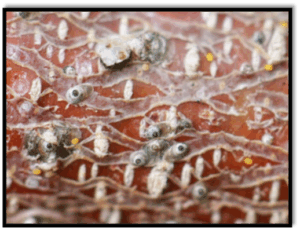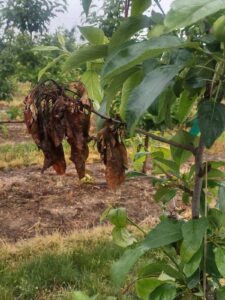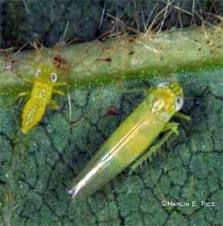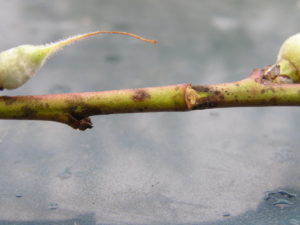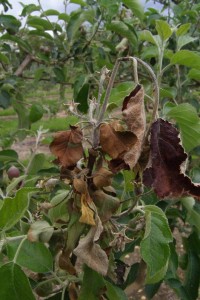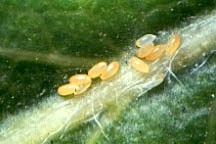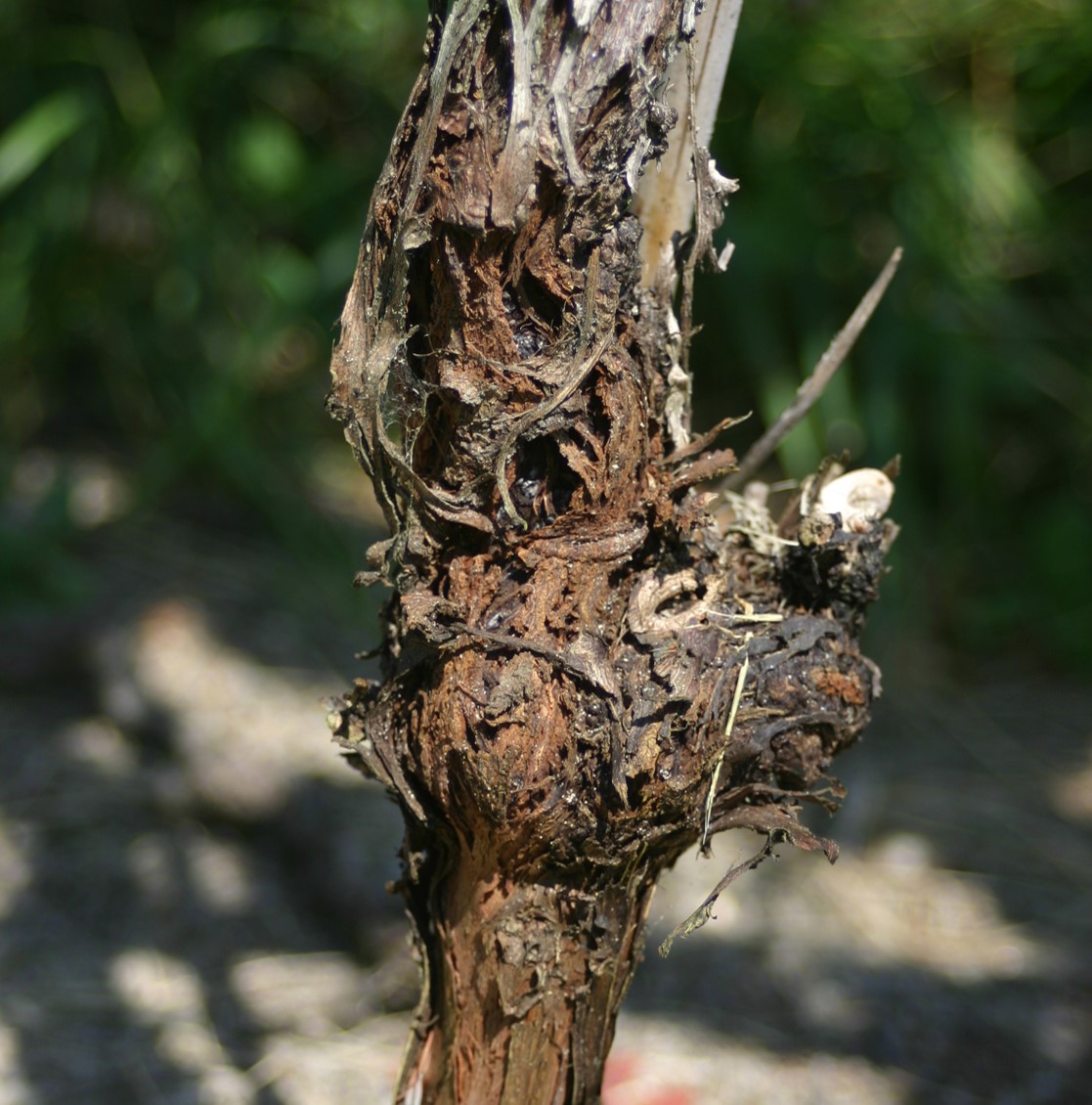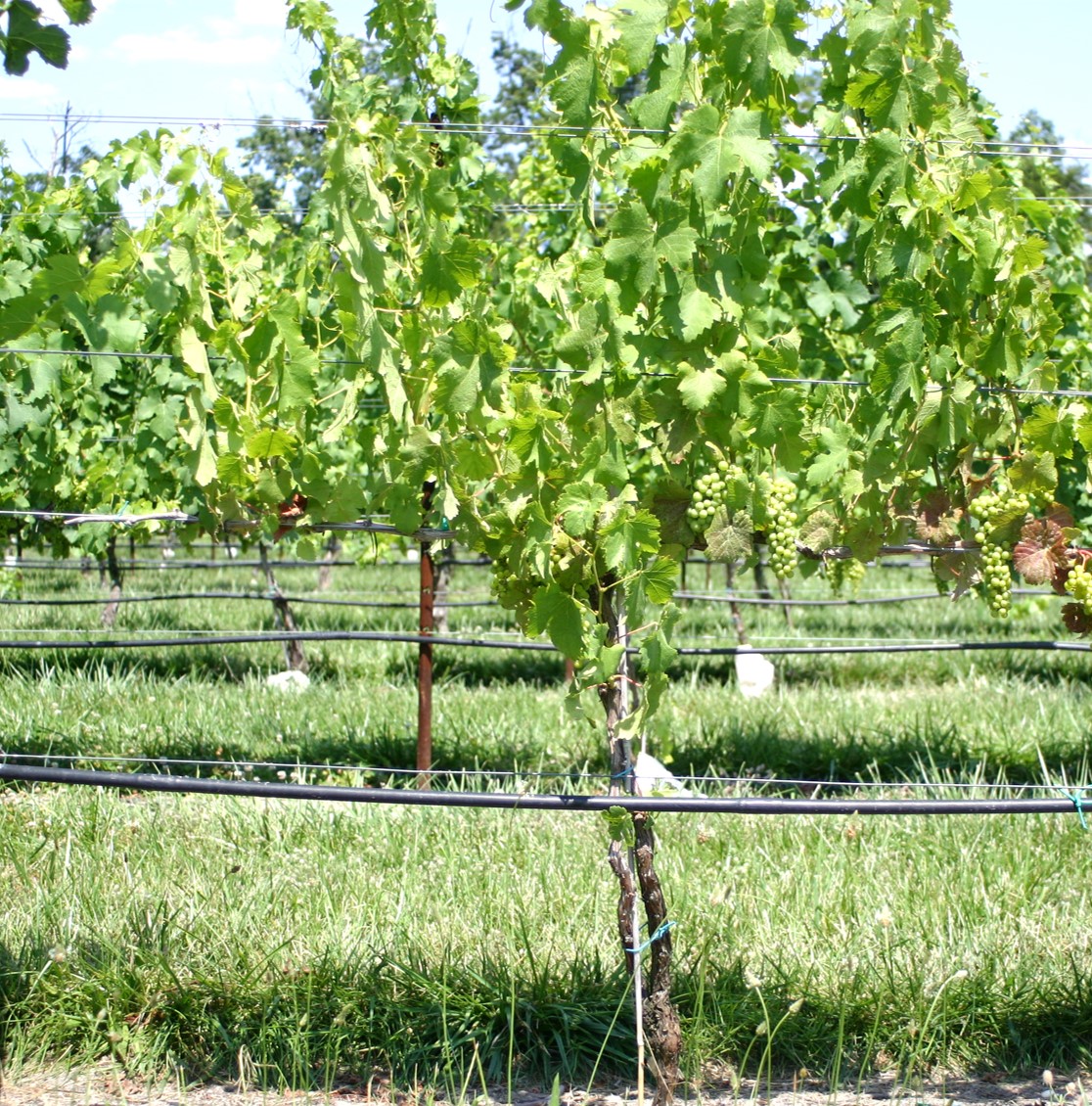Peach:
Diseases:
Bacterial Spot: Bacterial spot leaf symptoms appeared on highly susceptible varieties in southern counties starting in May. Leaf infections appear water soaked, stay within the leaf veins, and gradually darken (Figure 1). Eventually the chlorotic tissue abscises from the leaf leaving a “shot-hole”. Copper injury appears similar. The main differences are copper injury will often appear at the leaf bottom where the spray collects as it runs off, and the shot-hole will cross over leaf veins. Copper injury often has a red appearance at the shot-hole margins (Figure 2). Fruit injury from bacterial spot results in dark lesions that are often accompanied by gummosis. So far fruit symptoms are very low and only in highly susceptible varieties. Growers should continue to manage using Oxytetracycline and lower rates of copper, especially around rainy periods and severe weather. Fruit will become less susceptible to infection at pit hardening which should occur around the middle of June.
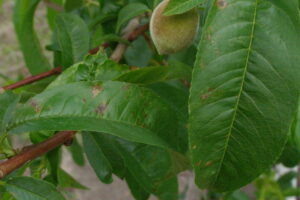
Figure 1. Bacterial spot infection on leaf in peach. Photo by David Schmitt.

Figure 2. Copper injury to peach leaf.
Rusty Spot: Rusty spot infections are appearing on fruit in southern counties and ongoing until pit hardening. Maintain coverage with effective materials such as Rally, Rhyme, or potassium bicarbonate products. Other choices include Flint Extra, Inspire Super, and Luna Sensation.
Peach Scab: Maintain good coverage with captan or other effective fungicides until July where scab was an issue last year.
Oriental Fruit Moth: A biofix point for OFM was set on 4/2 for southern counties and 4/17 in northern counties. All Treatments for the first generation have past.
| OFM 2nd Generation Timing | ||||
| Insecticide Type | ||||
| County/Region | Degree Days by 6/2 base 45 | Conventional
1150-1200 1450-1500 |
Intrepid/Rimon
1050-1150 1300-1400 |
Diamides/Virus
1075-1150 1375-1450 |
| Gloucester – Southern | 912 | 1st –June 11-13
2nd – too far off |
1st –June 7-10
2nd – too far off |
1st –June 8-10
2nd – too far off |
| Middlesex – Northern | 775 | 1st – too far off
2nd – too far off |
1st – too far off
2nd – too far off |
1st – too far off
2nd – too far off |
Tarnished Plant Bugs; and Other Catfacing Insects: Catfacing insects are active, but very little recent fruit feeding has been observed.
Green Peach Aphid: We are still observing aphid colonies above threshold at some farm sites. If more than 1 colony of aphids are found in nectarines, or 2-3 colonies are found in peaches, an insecticide for aphids is needed. See the NJ Commercial Tree Fruit Production Guide for recommended materials and rates.
Scale Insects: White peach scale and San Jose scale crawlers began emergence around mid-May in southern counties and San Jose scale crawlers began emergence around May 26 and will continue emergence for up to 6 weeks. Control options during crawler emergence include Neonicotinoids (suppression only), Sivanto, and the IGR’s Esteem and Centaur. See the NJ Commercial Tree Fruit Production Guide and the product labels for more information.
Apples and Pears:
Diseases: Now that primary scab is nearing the end, or has ended, the focus turns toward summer diseases such as fruit rots (esp. Bitter rot), and sooty blotch and fly speck. Bitter rot control has been difficult at best in recent years even where management programs have been rigorous. Research has suggested products such as Merivon, Luna Sensation, Inspire Super, Aprovia, and Omega may be effective, and longtime reliable broad spectrum fungicides such as captan and ziram should provide control. Experience has suggested that the addition of phosphorous acid products such as Prophyt or Rampart to captan sprays may improve control. Observations are that these products improve control of other summer diseases such as sooty blotch and flyspeck, and may help suppress scab infections where present. Scab symptoms are appearing in some orchards statewide.
Fire Blight: Fire Blight symptoms began appearing in southern county apple orchards the week of 5/19. Typically it is recommended to cut out infected limbs however this is a practical decision that must be made. This blog post from Michigan State may be helpful to decide whether it is worth cutting out infected tissue. Once the terminal buds set, typically in July, infected wood should be removed to prevent colonization by the bitter rot pathogen.
Codling Moth (CM): A Codling Moth Biofix was set in Southern counties on 4/28 and in Northern counties on 4/30. Codling moth applications for the first generation is due later this week into the weekend. See the chart below for timings based on location and the chemistry being used.
| Codling Moth Degree Day Timing | |||||||||
| Application and Insecticide Type | |||||||||
| County Area | Biofix | Rimon:
75-100DD + 14-17 days later
|
Intrepid
150 + 450 DD Diamides – Altacor, Voliam mixes: (150-200 DD) |
Madex
250 DD + every 7-9 days during brood hatch (later if first spray is an IGR) |
Standard Insecticides – Delegate, Avaunt, OP’s, carbamates, pyrethroids
250 DD + 550 DD
|
||||
| DD | 75 | 100 | 150 | 450 | 250 | 250 | 550 | ||
| Southern | April 28 | past | past | past | past | past | past | June 5 | |
| Northern | April 30 | past | past | past | June 4 | past | past | June 8 | |
Ambrosia Beetle : Infested trees are showing signs of stress. If you have had a history of this pest in your orchard, now is a good time remove and burn any trees that have been attacked as the flight appears to be declining or is over.
Wooly Apple Aphid (WAA); Green Apple (Spirea) Aphids (GAA): GAA colonies are present in some apple blocks. GAA is generally a pest that can be tolerated since they do little direct damage. Treatment thresholds for GAA are if 50% of the shoots are infested with no beneficial insects present. WAA colonies are also beginning to form in southern counties. In most years these are controlled by beneficials; however, in some years like 2022, serious outbreaks can occur. The best control for WAA is Movento applied before or when the first colonies appear. Diazinon is also effective at knocking down infestations. Movento will also control GAA and should control San Jose scale when applied in mid-May, and suppress scale when applied in late May or early June. Do not combine diazinon, oil, or oil-based penetrants with Captan.
Pear: Second generation pear psylla began hatching about 5/19. Options for control include spinosyn products such as Delegate and Entrust, and the neonicotinoids (IRAC group 4A). The addition of 0.25-1 gal of summer oil may improve control. Other options include Movento, the IGR’s Esteem and Centaur, and products containing abamectin. Be sure to read and follow the label instructions regarding the addition of penetrants for abamectin products, and Movento. Pear Psylla are still actively laying eggs and nymphs continue to hatch.
Grape: Early blooming native grapes were at trace bloom on 5/16, therefore we have set the Grape Berry Moth biofix at 5/16 for southern counties. Since V. riparia typically blooms with early natives we used Concord to set the biofix. The model works best when growers record their own bloom dates and use the Grape Berry Moth model at NEWA. Applications for GBM using Intrepid or Diamides should be made at 810 DD base 47. Other effective materials can be applied a few days later. Applications have been historically made around the end of June in southern counties. As for diseases, we are seeing low levels of phomopsis and symptoms of downy mildew beginning in some vineyards. Bloom is the critical time to protect against cluster infections from Downy and Powdery Mildew; Black rot; Botrytis; and ripe rot. Dr. Mizuho Nita at Virginia Tech has a comprehensive summary of fungicide choices for bloom.
Phenology Table: Based on annual observations made in Gloucester County.
| Pest Event or Growth Stage | Approximate Date | 2025 Observed Date |
| Bud Swell (Redhaven/PF-17) | March 23 +/- 15 Days | March 30 |
| 1/4″ Green Tip Red Delicious | March 31 +/- 13 Days | March 30 |
| Pink Peach (Redhaven/PF-17) | April 4 +/- 15 Days | April 1 |
| Tight Cluster Red Delicious | April 9 +/- 13 Days | April 5 |
| Full Bloom Peach (Redhaven/PF-17) | April 9 +/- 14 Days | April 10 |
| Pink Apple (Red Delicious) | April 14 +/- 12 Days | April 16 |
| Full Bloom Apple (Red Delicious) | April 22 +/- 11 Days | April 25 |
| Petal Fall (Redhaven) | April 22 +/- 10 Days | April 19 |
| Petal Fall (Red Delicious) | April 27 +/- 13 Days | May 2 |
| Shuck Split (Redhaven) | April 30 +/- 11 Days | April 26 |
| Pit Hardening | June 15 +/- 9 Days |
Tree Fruit Trap Captures – Southern Counties
| Week Ending | STLM | TABM-A | CM | BMSB | OFM-A | DWB | OFM-P | TABM-P | LPTB | PTB |
| 4/5/2025 | 0 | 0 | 0 | 0 | 0 | 0 | 0 | 0 | 0 | 0 |
| 4/12/2025 | 0 | 0 | 0 | 0 | 6 | 0 | 0 | 0 | 0 | 0 |
| 4/21/2025 | 0 | 0 | 0 | 0 | 36 | 0 | 1 | 0 | 0 | 0 |
| 4/27/2025 | 25 | 0 | 0 | 0 | 24 | 0 | 5 | 0 | 1 | 0 |
| 5/2/2025 | 517 | 0 | 4 | 0 | 12 | 0 | 6 | 0 | 13 | 0 |
| 5/9/2025 | 159 | 4 | 10 | 0 | 3 | 16 | 5 | 4 | 46 | 0 |
| 5/16/2025 | 91 | 11 | 6 | 0 | 1 | 36 | 2 | 14 | 69 | 0 |
| 5/23/2025 | 299 | 21 | 3 | 0 | 1 | 23 | 1 | 26 | 23 | 0 |
| 5/30/2025 | 399 | 14 | 2 | 0 | 0 | 41 | 1 | 11 | 10 | 3 |
Tree Fruit Trap Captures – Northern Counties
| Week Ending | STLM | TABM-A | CM | BMSB | OFM-A | DWB | OFM-P | TABM-P | LPTB | PTB | AMBROSIA BEETLE |
| 4/5/2025 | 387 | 0 | 0 | 0 | 0 | 0 | 0 | 0 | 0 | 0 | 0 |
| 4/21/2025 | 435 | 0 | 0 | 0 | 0 | 0 | 1.3 | 0 | 0 | 0 | 0 |
| 4/27/2025 | 26 | 0 | 0 | 0 | 0 | 0 | 25 | 0 | 0 | 0 | 72 |
| 5/2/2025 | 86 | 0 | 0.33 | 0 | 72.5 | 0 | 47.2 | 0 | 0 | 0 | 136 |
| 5/9/2025 | 56 | 0 | 5.3 | 0 | 58.8 | 0 | 22.9 | 0 | 0 | 0 | 145 |
| 5/16/2025 | 13.75 | 2.6 | 7.3 | 0 | 4 | 0 | 5 | 0 | 0 | 0 | 50.5 |
| 5/23/2025 | 4.8 | 10.3 | 10.5 | 0 | 0.6 | 31.25 | 4.2 | 0 | 14.6 | 1 | 22.2 |
| 5/30/2025 | 2.2 | 4.8 | 1.8 | 0 | 0 | 12.4 | 9.6 | 0 | 9.6 | 1.9 | 22.1 |

